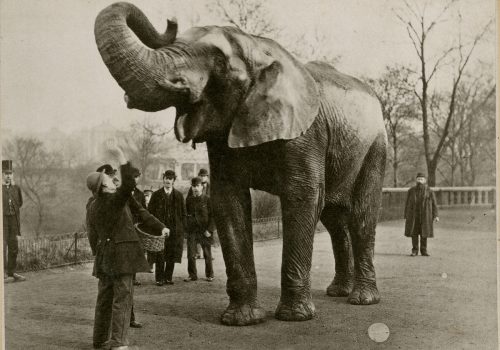Animals have appeared in art for millennia as subjects of wonder, symbols of human triumphs and victims of man’s rapacity. An exhibition of animals in photography from 1845 to 2009 will be exhibited by Hans P. Kraus Jr. Fine Photographs from September 17 through November 15, 2019. The exhibition, By Hoof, Paw, Wing or Fin, explores some of the ways in which photographers have represented animals over the course of the medium’s history and features an array of animal life, from birds, butterflies, and fish to lions, hippos, and elephants, in the work of Hill & Adamson, Alois Auer, Giacomo Caneva, J. D. Llewelyn, Martin Munkacsi, Edward Steichen, Adam Fuss, and others.
Almost immediately after the introduction of photography in 1839, artists were documenting their homes, travels, and favorite leisure activities. Early practitioners were as interested in chemistry and optics as they were in the aesthetics of their images. They soon saw photography to be a powerful tool for scientific observation. Nineteenth-century scientists utilized the new medium to advance knowledge and unlock the secrets of nature. The popularity of animal photographs later in the 19th century grew with the rise of the public zoological garden in large cities across Europe. These early zoos offered people opportunities to view rare and wild animals close up for the first time.
The earliest photograph in the show is an 1845 salt print from a calotype negative by the Scottish team of D. O. Hill & Robert Adamson (1802-1870 & 1821-1848) depicting the Newhaven fishwives Jeanie Wilson and Annie Linton, “twa bonnie lasses,” contemplating their selection of fish for sale.
The albumen print of Reclining goat in Rome, circle of Giacomo Caneva, 1850s, illustrates a threshold between the old and new in mid-19th-century Rome. The goat’s resting place on the steps defies our idealistic vision of it wandering freely in its natural setting.
Oxen in snow, a quarter plate daguerreotype made through a window by an unknown American photographer in the 1850s, depicts a team yoked to a cart. A cocker spaniel eyes the photographer in Jake’s dog, Dash, a half-plate tintype from 1879. The dog’s pose together with his name plainly evident in the plate make this a fine example of the tintype process.
Zoos made it possible to photograph unusual and exotic animals in captivity for the first time. But it is Jumbo the elephant, here featured in Edward Bierstadt’s 1882 artotype, who is the stuff of legend. Born in Sudan, exhibited in zoos in Germany, Paris, and London, Jumbo was purchased by P.T. Barnum in 1882 and brought to the U.S. where he was shown widely, enhancing Barnum’s fame.
A portfolio of Peter Nissen’s albumen prints, circa 1891, of animals in training and performing at Carl Hagenbeck’s Zoological Circus is also on display. Hagenbeck , an internationally renowned animal dealer and trainer based in Hamburg, supplied exotic animals to zoos and private menageries in Europe and the United States. To produce some of the photographs for this album Nissen added details of animals, even other animals, to negatives by hand and sometimes fused multiple negatives together to make his prints, hybrids of the real and the surreal. Nissen was known to sometimes retouch his work, removing bars, chains, and any evidence of mistreatment of the animals. Hagenbeck prepared portfolios such as this for presentation to his loyal customers.
In the mid-19th century, painters revisited the work of 17th- and 18th-century masters of still life. This revival enhanced the popularity of photographs modeled on the conventions of still-life painting. On display is Hugh Welch Diamond’s Still life with hare, 1856, and Still life with parrot, fruit and goblet, 1860s, by Ferdinand Küss. Also included is a glorious autochrome by the Lumière Brothers studio, Still life with fish, circa 1907, an artful arrangement of seafood and kitchenware. Autochromes were made by a process invented and patented in 1904 by Louis Lumière (1864-1948), the younger of the two brothers who figured prominently in the invention of the motion picture.
By the end of the first decade of the 20th century, Pictorialism’s emphasis on a selective soft focus was giving way to sharp photographs that reexamined familiar subjects in radically new ways. Edward Steichen (1879-1973) abandoned Pictorialism in favor of a more direct form of photography with clearly defined detail. His 1921 toned gelatin silver print Grasshopper and wheat stalk is a fine realization of Steichen’s new aesthetic.
Though best known for revolutionizing fashion photography with a naturalistic and energetic style, Martin Munkacsi (1896-1963) spent his early years photographing street life, sports, entertainers, and politics in Germany and Hungary in the late 1920s and ‘30s. His circa 1929 gelatin silver print of a roaring hippopotamus places the beast’s gaping jaws in full focus as if to swallow the viewer whole.
By Hoof, Paw, Wing or Fin: Creatures in Photographs
September 17 through November 15, 2019
Hans P. Kraus Jr. Fine Photographs
962 Park Avenue at 82ndStreet
New York City
















